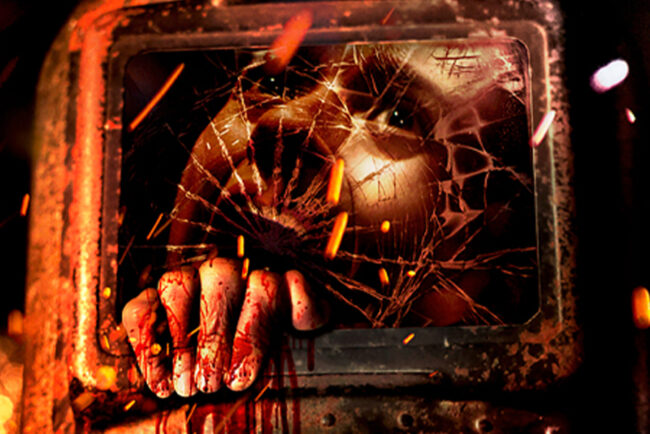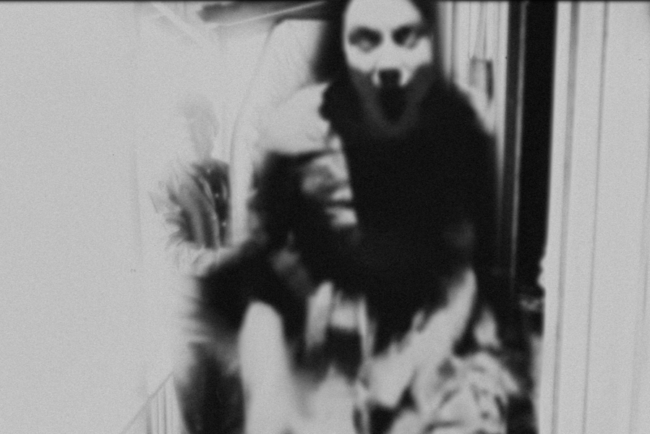
Of all the practitioners of the Weird Tale, perhaps none is as slippery as H.P Lovecraft. Despite being among the most well-known figures in horror literature for the last century, adaptations of his works are relatively few and far between. When an adaptation does rise from the depths, the end result often bears little resemblance to the story from which it is based.
Lovecraft’s stories are predicated on the fear of the unknown and the unknowable. The things that lurk in the dark, and in the spaces beyond the darkness. The typical Lovecraft story ends when the narrator catches the briefest glimpse of the horrors beyond our world. Upon realizing the implications of the nightmares they’ve witnessed, they are driven to madness. The reality of Lovecraft’s monsters is so cosmically unfathomable that mere implication of their existence is enough to drive one insane.
In prose, such ideas can work (sometimes). In cinema, that just doesn’t fly. Sure, you can toy around with implications and suggestions, but by the end of the movie, you’d better show the damn monster or you’ll have some pretty unhappy viewers. Thus is the inherent peril courted when adapting a Lovecraft story. Stick too close to the source material and rather than instilling the audience with awe and horror, all the audience feels is boredom. Stray too far, and you lose the very essence of that Lovecraftian mood.
H.P. Lovecraft’s Witch House is the latest attempt to bring Lovecraft to the cinematic realm. Directed by Bobby Easley, and written by Easley and co-writer Ken Wallace, the movie is based on Lovecraft’s 1932 short story The Dreams in the Witch House.
Miskatonic University student Alice (Portia Chellelynn) is studying the possible existence of alternate dimensions. In her studies she finds that certain geometric patterns, Non-Euclidian Geometry, may hold the secret to her research. When a personal tragedy necessitates a move into a new living situation, she takes up residence in the attic of the notorious Hannah House. Despite the vermin infestation in her room and the bizarre behavior of her housemates, Alice is thrilled to discover that the shape of her room’s architecture is an exact match for the geometric patterns related to her studies. With the help of another resident, Tommi (Julie Anne Prescott), Alice dives into the history of the house and the meaning behind the shape of her room.
If you’ve read a Lovecraft story before, you have a pretty good idea where this is headed. If you have not read a Lovecraft story before, you still have a pretty good idea where this is headed.
H.P. Lovecraft’s Witch House takes its sweet time getting to the meat of things. After a stellar opening credit sequence, and a nice, bloody introduction, the pace grinds to a halt as the plot elements are set up.
When the lurking evil finally creeps its way into Alice’s life, the movie truly shines. Kaleidoscopic editing, and stark colors fill the screen. Deep blues coat the scenes like a monochromatic painting. Bright greens and reds fade in and out again as bizarre apparitions dance and cavort across the screen. Garish rituals and erratic behavior dominate the frame. Like Alice, the viewer can never quite make complete sense of what the images mean. But one thing is clear: it’s evil.
Visually, during the hallucinatory nightmare sequences, the movie commands complete attention. For the rest of the running time, unfortunately, the movie’s not quite as strong. Plot development is clunky and utilitarian. Scenes and dialogue exist to establish some story element or another, and provide little in the way of entertainment, or even just engagement. Characters plod their way through scenes in aimless slice-of-life moments. Repeated motifs of child abductions and satanic imagery break up the monotony, hinting at the plot to come. Such sequences are ominous, but never quite feel Lovecraftian.
The great irony in that being that as an adaptation, the movie is largely faithful to the original text. The short story itself is often criticized for being less Cosmic Horror, and more along the lines of your classic Occult Horror.
Whether this works for you will be a matter of personal taste, but as far as faulty adaptations go, we can’t blame the filmmakers for this one not feeling like Lovecraft. The blame falls squarely on Lovecraft for not feeling like Lovecraft. The adaptation is pretty spot-on.
All that said, you might expect that after weighing the pros and cons, H.P. Lovecraft’s Witch House may not be worth your time. You might think that bizarre imagery and cool colors may not be enough to override the limitations of plot and storytelling.
You would be wrong. This movie rules. It more than makes up for any shortcomings in the plot by embracing the spirit of low-budget, schlocky horror of years past.
Gore makes its presence known from the introductory scene, and a healthy dose of senseless violence rears its head a time or two as things progress. Not as much as I would prefer, but enough to keep things interesting. Spontaneous sex scenes erupt for no reason and completely gratuitous nudity flashes across the screen just often enough to remind you that cinema truly is the greatest form of art.
Forgive me for being crass, but the fact of the matter is H.P. Lovecraft’s Witch House is exactly the breath of filthy air that I needed in my life. It’s the perfect party movie. Grab some friends, gather your favorite recreational substance, and feel free to talk during the boring parts. You’ll miss key pieces of information, but who cares? The cool parts are just around the corner, and the less you know about the plot, the better. After all, uncovering the truth may just drive you to madness.
H.P. Lovecraft’s Witch House will be available on DVD and VOD July 5.
















